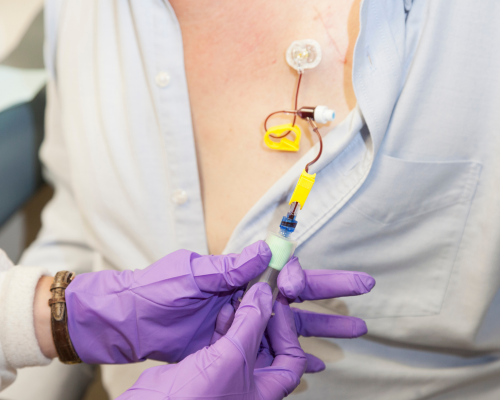Vascular Access for Chemotherapy
What is Vascular Access for Chemotherapy?
Vascular access for chemotherapy refers to the method of delivering chemotherapy drugs directly into the bloodstream using a specialized device. Since chemotherapy involves repeated administration of medications that can irritate veins, vascular access devices (VADs) are used to ensure safe, efficient, and comfortable delivery.
Why is Vascular Access Important?
- Frequent Treatments: Chemotherapy often requires multiple sessions over weeks or months.
- Irritating Medications: Many chemotherapy drugs are harsh on smaller veins and surrounding tissues.
- Improved Comfort: Reduces the need for repeated needle insertions during each session.
- Efficient Delivery: Allows high doses of drugs to be administered directly into larger veins, ensuring quicker distribution in the body.
Types of Vascular Access Devices (VADs)
- Peripheral Intravenous Catheter (PIV):
- Inserted into a vein in the hand or arm.
- Suitable for short-term chemotherapy.
- Central Venous Catheter (CVC):
- Inserted into a large vein in the chest or neck.
- Types of CVCs include:
- Hickman Catheter: Commonly used for chemotherapy.
- Groshong Catheter: Equipped with a valve to prevent blood backflow.
- Peripherally Inserted Central Catheter (PICC Line):
- Inserted into a vein in the arm and threaded to a large vein near the heart.
- Suitable for intermediate-term chemotherapy.
- Implanted Port (Port-a-Cath):
- A small device placed under the skin, connected to a catheter that leads to a large vein.
- Ideal for long-term use and requires minimal maintenance.
How Vascular Access for Chemotherapy Works
- Preparation:
- Local anesthesia is applied before inserting the VAD.
- The procedure is minimally invasive and typically performed under sterile conditions.
- Device Placement:
- A catheter is guided into a central vein, such as the superior vena cava.
- For implanted ports, the port is placed under the skin, making it less visible and reducing infection risk.
- Chemotherapy Administration:
- The device allows for easy and repeated access to the bloodstream.
- After treatment, the device is flushed with saline or heparin to prevent clotting.
- Monitoring:
- Regular check-ups ensure the device remains functional and free from infection.
Benefits of Vascular Access Devices
- Reduced Discomfort: Eliminates frequent needle sticks.
- Reliable Access: Ensures consistent and stable delivery of medications.
- Lower Complications: Minimizes vein irritation and extravasation (leakage of drugs).
- Convenience: Implanted ports allow patients to carry out daily activities without restrictions.
Risks and Precautions
While vascular access devices are generally safe, some potential risks include:
- Infections: Proper hygiene and care can prevent infections at the catheter site.
- Clot Formation: Routine flushing prevents clots from forming in the catheter.
- Device Malfunction: Rarely, catheters may need adjustment or replacement.
To minimize risks, vascular access is managed by skilled professionals in a sterile environment.
Caring for a Vascular Access Device
- Hygiene: Keep the insertion site clean and dry.
- Follow Instructions: Adhere to the care routine provided by your healthcare team.
- Watch for Signs of Infection: Redness, swelling, or fever should be reported immediately.
- Flushing: Regular flushing helps keep the device clear and functional.
Why Choose Dr. Chainulu for Vascular Access?
Dr. Chainulu and their team specialize in vascular procedures, offering personalized care for chemotherapy patients. Using advanced techniques and state-of-the-art equipment, they ensure:
- Precise placement of vascular access devices.
- Minimally invasive procedures for quick recovery.
- Comprehensive aftercare to maintain device health.
Frequently Asked Questions
1. How long does it take to place a vascular access device?
- Most procedures take 30–60 minutes and are performed on an outpatient basis
2. How long can a vascular access device stay in place?
- Duration depends on the type of device and treatment plan. Ports and CVCs can stay for months or even years.
3. Is the procedure painful?
- Local anesthesia is used, so the procedure is generally painless. Mild discomfort may occur at the insertion site.
4. How do I know if my device is working properly?
- Regular follow-ups with your healthcare provider ensure the device functions optimally.

Our Services
- Varicose Veins
- Deep Vein Thrombosis
- Vascular Malformation
- Aortic Aneurysms
- Mesenteric Vasculature
- Acute Limb Ischemia
- Peripheral Arterial Disease
- Stroke Prevention
- Angiography
- Vascular Access for Chemotherapy
- Spider Veins
- Glue Therapy
- Sclerotherapy
- AV Fistula
- Uterine Fibroid Embolisation
- Varicocele Embolisation
- Thyroid Ablation
- TACE
- Prostatic Artery Embolisation
- Varicocele Embolisation
